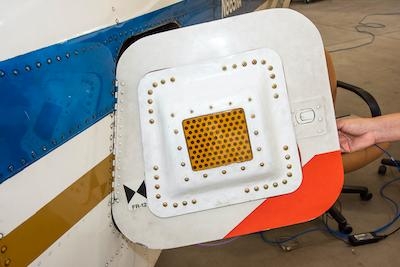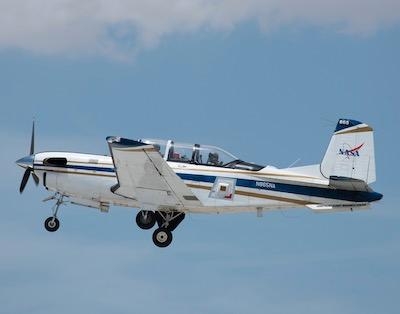Designed To Minimize Drag To Gain Efficiency Compared To A Conventional Satellite Dish
NASA’s four aeronautics research centers collaborated to create a new lightweight antenna to boost aircraft and antenna performance.

This unique conformal antenna is designed to minimize drag to gain efficiency compared to a conventional satellite dish. Current satellite dishes are heavy and bulky and require a gimbal to maneuver and point at different satellites for communications.
This multicenter effort used aerogels to develop the conformal antenna under the Conformal Lightweight Antenna Structures for Aeronautical Communications Technologies (CLAS-ACT) activity within the Convergent Aeronautics Solutions project. NASA’s Ames Research Center and Armstrong Flight Research Centers in California, Glenn Research Center in Ohio and Langley Research Center in Virginia are the agency’s aeronautics centers.
The CLAS-ACT team set out on a mission to design a lightweight antenna using aerogels that consist of 90% air. Aerogels are very lightweight compared to conventional antenna materials, which can result in a thin, flexible antenna with improved gain, bandwidth and efficiency.
The conformal antenna is made of 64 small antennas that combine to perform the function of one large antenna. The antenna can also maneuver the signal, minimizing interference with ground users in ways not possible with a traditional antenna.
The antenna is designed with a new commercial phased array chipset to enable a small size, low-weight and power solution for beyond line-of-sight communications on small to medium scale unmanned aircraft systems (UAS). The phased array chipset reduces radio interference to ground stations to address interference concerns from UAS being integrated into the national airspace.

The phased array demonstrated the ability to lower side lobes, or unintentional radiation from the antenna, as the conformal antenna delivers its signal to its intended target.
The project team performed flight tests with the antenna installed on the luggage door of a T-34C aircraft. A newly developed robotic antenna scanner allowed for extended preflight testing and verification. Both tests measured the antenna’s pattern characteristics to determine the feasibility of the interference mitigation techniques. The team completed five flight tests including four antenna configurations within a variety of flight altitudes and demonstrated a reduction of side lobes.
The antenna was designed and tested in the anechoic chamber at Glenn, the on-aircraft modeling of the antenna’s performance happened at Langley Research, the preflight planning was accomplished at Ames Research and the integration and flight tests occurred at Armstrong.
The CLAS-ACT team has documented its research outcomes and lessons learned to support aeronautics as more companies introduce their UAS. The cross-center collaboration will continue as the team determines its next steps.
(Images provided with NASA news release)
 ANN's Daily Aero-Term (04.25.24): Airport Rotating Beacon
ANN's Daily Aero-Term (04.25.24): Airport Rotating Beacon ANN's Daily Aero-Linx (04.25.24)
ANN's Daily Aero-Linx (04.25.24) Klyde Morris (04.22.24)
Klyde Morris (04.22.24) Airborne 04.24.24: INTEGRAL E, Elixir USA, M700 RVSM
Airborne 04.24.24: INTEGRAL E, Elixir USA, M700 RVSM Airborne 04.22.24: Rotor X Worsens, Airport Fees 4 FNB?, USMC Drone Pilot
Airborne 04.22.24: Rotor X Worsens, Airport Fees 4 FNB?, USMC Drone Pilot




